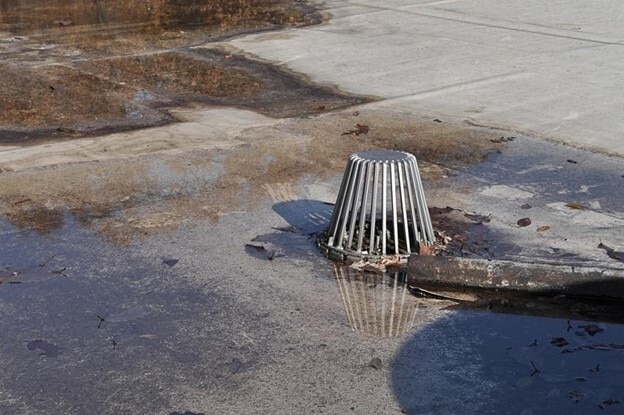El sistema de techos comerciales de pendiente baja se encarga de mantener los elementos fuera del edificio. En épocas de lluvias intensas, el agua no tiene dónde ir y puede estancarse en el techo. A roof drain prevents water from ponding by providing a way for it to leave the roof, and regular commercial drain maintenance ensures its continued performance.
Although commercial buildings may appear to have flat roofs, some roofs have slopes built into the structure or require added slopes, typically achieved with tapered insulation to facilitate water drainage. Esta pendiente está diseñada para guiar el agua hacia un desagüe, para que no se acumule en el techo y dañe al sistema de techo o a la estructura. El agua estancada puede deteriorar lentamente determinados materiales para techos y generar degradación prematura, fallos o daños. It can also promote algae and plant growth and attract nuisances such as birds and insects.
Guiding Water off the Roof
Residential roofs have gravity on their side-water flows down the slopes into gutters that transport it away from the home. Commercial buildings with low-slope roofs have to work a little harder to remove water, which is where roof drains come into play.
The roofing system design can help guide water toward the drains. It often involves using tapered insulation such as GAF EnergyGuard™ tapered polyiso insulation. Los dos tableros biselados más populares proporcionan una pendiente de 1/8 de pulgada o 1/4 de pulgada por pie. This slight slope prevents water from standing on the roof, forcing it toward a drain strategically installed at various low points on the roof with crickets and saddles.
Drain placement is particularly essential when the parapet wall sheds water. Para ayudar al agua a llegar a la línea del desagüe o canaleta, por lo general, se instalan desviadores "crickets" en esquinas y entre los desagües para dirigir el flujo y aliviar la acumulación de agua. This water must flow down the roof side of the parapet wall and follow the roof slope to reach the drain.
3 Common Types of Roof Drains
Inner Drains
Inner drains are connected to sloped pipes under the roof that carry water off the roof and away from the building. They typically rely on gravity and the roof's slope to get water to the drain.
Scuppers
Scuppers are found at the roof's edge, usually installed through a hole in the parapet wall. They're designed to drain water from the roof into a downspout or may extend out from the building to shed water.
Siphonic Drains
Siphonic drains feature a baffle that keeps air out and allows water to fill the pipes. Una vez llenas las tuberías, la falta de aire crea un vacío que extrae agua del techo a alta velocidad. The baffle also keeps leaves and debris from gathering in the drain and causing a blockage.
Caring for and Maintaining Roof Drains
Inspecting and maintaining roof drains should be part of your regular roof inspections. Debido a que los desagües de techos se ubican en puntos bajos del techo, es fácil que se acumulen desechos u hojas en estas áreas. Limpiar los desechos es esencial para que los desagües funcionen de forma adecuada. Las obstrucciones generan la formación de charcos de agua en el techo, que pueden causar problemas estructurales en el edificio. Even just an inch of standing water can add thousands of pounds of weight to the roof, reinforcing the need for regular commercial drain maintenance.
Advancing Roof Drain Maintenance with Technology
GAF recently introduced the Steely Drain™. Esta es una solución de desagüe de techo que utiliza tecnología que permite a los contratistas desarrollar su relación de mantenimiento, a través de recordatorios de mantenimiento del edificio para contactar a los propietarios del edificio o encargados de las instalaciones. This contractor-inspired drain is made of 316L marine-grade stainless steel, making it ideal for tough environments that require exceptional corrosion resistance.
Steely Drain™ features a QR code etched onto the top that you can scan with your smartphone to instantly view information about the roofing system. This data can include the contact information of the contractor who installed the system, the architect and consultants for the project, and the roofing system details if all information is inputted.
This critical data is managed from a convenient GAF-hosted dashboard and plays an important role in the roof's maintenance plan. Los contratistas pueden establecer y recibir recordatorios de correo electrónico cuando sea momento de realizar inspecciones de desagües y techos programados. The dashboard also eliminates the need for core cuts since every detail of the roofing system is available through the QR code-from the deck type to the cover board, underlayment, insulation type and thickness, to the final membrane.
Knowledge Is Key to Success
When properly installed and maintained, roof drains can keep the rooftop free of standing water for many years. ¿Tienes curiosidad por saber más? Explore how the Steely Drain™ can help you with your ongoing maintenance programs. You can also visit the GAF CARE Contractor Training Center to gain additional tips and access valuable training courses that allow you to learn at your own pace.

